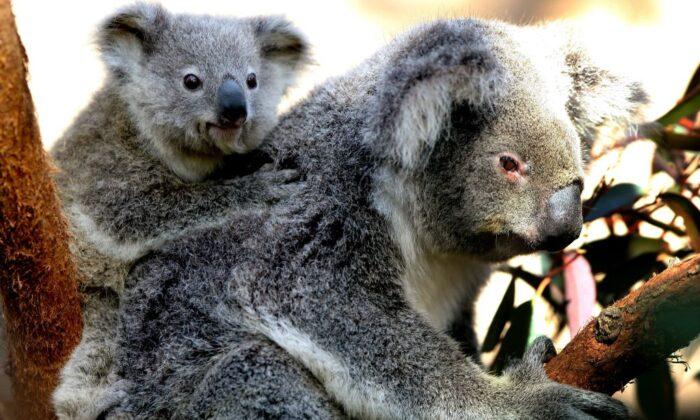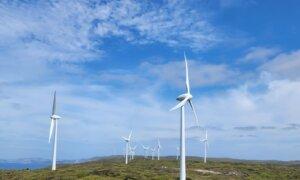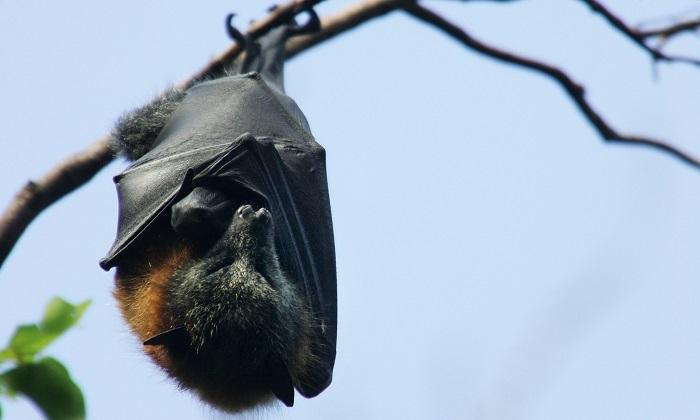Roger Martin is a zoologist who lives in Queensland’s far north Atherton Tablelands, and has spent much of his career studying the marsupial.
He feels many are unaware of the plight of Australia’s endangered koalas, with a line-up of wind farms proposed in the state’s most precious remnant forests.
Not only do wind farms require land clearing, Martin fears the noise from turbine blades could drown out koala mating calls, or bellows, making it near-impossible for the marsupials to locate one another.
Koalas possess an enlarged middle ear, adapted to detect low-frequency sounds, allowing them to hear each other across the bush—mating calls can be audible from several kilometres away.
But the “whirring” of giant wind turbine blades can travel even farther and at higher frequencies, potentially drowning out the koalas.
Martin says current studies into the impacts of wind farms on the ecological systems of Queensland’s wet eucalypt forests are inadequate.
“There’s no assessment of environmental impact,” he told The Epoch Times.
“We’re saying they shouldn’t put the wind farms there. For millions of years, [koalas have] lived in a silent landscape.
“You’re sterilising the wildlife.”

Why Queensland’s Forests Are Critical for Koalas
The north Queensland eucalypt forests Martin speaks of are a sanctuary for koalas and will be pivotal in sustaining populations as temperatures rise, in accordance with climate science.The forests sit at five degrees Celsius cooler than the coast, meaning that koalas may not survive hotter temperatures in the coming decades.
Forests on the edge of the wet tropics are also protected from another major threat to koalas: fire. During the peak fire season in summer, when other locations are at risk, wet eucalypt forests are usually drenched in tropical rain.
Bushfire events have the potential to wipe out tens of thousands of koalas in one fell swoop.

David and Goliath
Martin is currently opposing the construction of a wind farm in the tropics, but fighting every project borders on the impossible for environmentalists.Legal action requires that each project be challenged in court. Over and above that, in the race to net zero, projects are approved so quickly that research and evidence to back an appeal cannot be gathered in good time.
Further, experts are often hard to find, because many work for universities or consulting firms that have affiliations with wind farm companies.
The financial cost is also high, with environmentalists unable to compete with wind farm companies when it comes to paying for legal representation.
Yet lawyer Dominica Tannock of DST Legal is taking on several cases against wind farms in Australia, and admits the process can be difficult.
“It is David and Goliath,” she said. “It is really, really hard.”
Once in court, Tannock said hearings were often fair, but the process of getting to the courtroom is tedious, expensive, and logistically difficult.

What Makes a Site Ideal for Wind Farms?
A total land mass equivalent to the size of Tasmania is expected to be developed across Queensland to house renewables, involving hundreds of wind turbines, thousands of kilometres of new access roads to transport the wind turbines, and around 114,000 hectares of forest destruction, with each turbine requiring two hectares of land to be cleared.“The problem with Queensland is we [also] do not have the wind along the coast where the electricity’s being consumed, so, therefore, developers need to scale the heights of the coastal ranges and the Great Dividing Range to get the elevation to tap into any of those wind resources that are available,” says environmentalist Steven Nowakowski.
“And it is these areas that have [for years] escaped industrialisation, urbanisation, and agriculture due to their rugged terrain and inaccessible topography,” the nature photographer told The Epoch Times.
The Wildlife Preservation Society of Queensland also argues that the state simply does not have the abundance of wind resources that Australia’s southern states do.
The Snowballing Impact on Nature: Botanist
Jeanette Kemp, the former principal botanist for the Queensland government, authored a report this year on the effects of renewable developments on plants and vegetation.“The onslaught of renewable energy projects being fast-tracked in Queensland includes many projects located within high-quality tracts of intact native vegetation with very significant conservation values,” she told The Epoch Times.
“What some might consider a suitable compromise for moving away from coal is, in fact, another example of large foreign-backed or foreign-owned companies taking advantage of an almost unregulated opportunity to secure land for development.
“Unfortunately, the conservation movement in Australia generally does not want to confuse supporters by describing the issues as complex, or that not all of these developments are green.
“Because of this and the great speed at which renewable developments are going ahead, we are paying a very high price in terms of the degradation of rugged, remote, and ecologically important ranges.”
Another Overlooked Issue
Kemp’s findings revealed risks to endangered plants and animals, as well as the “substantially overlooked” issue of weeds.Weeds are known to spread after bushland and vegetation are disrupted by activities such as land clearing, posing further threats to flora and fauna.
Another hidden risk, according to Kemp, is hydrological changes resulting from road construction that require deep cuts into the earth.
These changes, she said, can alter the direction and rate of water flow and cause gullies to silt up or dry up entirely—something that could further encourage weed growth and threaten species like the nationally vulnerable Magnificent Brood Frog, which relies on shallow gullies to survive.
Kemp said the “offsets” used by developers were very “basic”—according to state and federal requirements—and rarely resulted in the equivalent replacement of habitat.
“For wind farms in Queensland, usually only nationally threatened animal or plant species are required to be offset, whilst state-listed species or regional ecosystems are apparently not considered,” she said.
“Unfortunately to date, most of the wind farm offset proposals are bordering on, or actually are, quite ludicrous.”

Kemp argued that if the public were fully aware of the impact of these proposals on the environment, there would be considerable backlash.
“Unfortunately, the pace at which these proposals are being approved, mean that the public is poorly informed or completely unaware,” she said.
While supportive of renewable energy, Kemp called for an urgent review of all current Queensland proposals in remnant vegetation areas and for a halt to projects requiring land clearing.
Perks for Polluters and Politics
Lawyer Tannock contends that koalas and native flora and fauna are being overlooked because of the relationship between foreign companies and the Australian government.Large foreign companies are eager to achieve carbon neutrality, and Tannock says some of them involved in Australia’s wind farms are big polluters because they are involved in mining and processing zinc, oil, gas, or coal resources.
“Any company that’s got the word ‘Australia’ in its name is probably a foreign company,” she said.
Rather than developing cleaner methods within their industries, those companies come to Australia to clock up carbon credits by building wind farms in order to “offset” their own pollution—making the company appear cleaner and greener than it is.
They can then claim to be “net zero,” while benefitting from Australian taxpayer-funded subsidies. At the same time, they build wind farms near existing transmission lines to save on costs.
“People are beginning to scrutinise companies,” Tannock said. “What they’re doing is polluting our country.”
For the Australian government, foreign investment provides a financial shot in the arm, while also securing the support of inner-city votes keen on additional climate change action.
“It’s been driven by pollsters who say if you approve a wind farm, it’s popular with the electorate,” Tannock said.

Queensland Senator Matt Canavan, who has long opposed renewables, says thousands of hectares of koala habitat are at risk.
“While we are promised that wind energy is here to save our environment, in reality, it is destroying our landscapes,” he told The Epoch Times.
“Compared to nuclear energy which only uses 0.3 square metre of land for every MWh produced, wind farms use up to 247 square metres of land for every MWh produced,” the Nationals senator said.
“For the Clarke Creek Wind Farm, just one of many under construction in Central Queensland, up to 1,513 hectares of suitable koala habitat is in the firing line.
Difficulty Finding Answers
Finding a solution to the environmentalists’ concerns has not been straightforward.Due to being in caretaker mode, the office for Queensland’s Labor Environment Minister Leanne Linard directed The Epoch Times to the state’s Department of Environment.
That department then directed inquiries to the Queensland Department of Energy and Climate.
Eventually, the federal Department of Climate Change, Energy, and the Environment responded.
A spokesperson confirmed that koalas are listed as endangered in Queensland, New South Wales, and the Australian Capital Territory, and that any action likely to impact koala populations had to be referred for consideration under national environmental law, and that approval would only be given after a “rigorous assessment.”
The government said wind farm projects needed to have an acceptable level of mitigation or offset provisions to balance the potential harm to the environment.
However, the spokesperson noted that the “Australian government is not responsible for the siting of wind farms,” and finding locations was the prerogative of renewable companies.
The federal government has invested $65.1 million (US$43.5 million) in targeted scientific studies to improve environmental data and regulatory guidance for renewables.
Wind Farm Builder’s Community Engagement
The Epoch Times also contacted Squadron Energy, the developer behind the Clarke Creek project for comment, but did not receive a response.Earlier this month, the company announced it would provide financial support to Safe Haven-Australian Animals Care and Education (Safe Haven-AACE) to build enclosures for injured and sick koalas.
Clarke Creek Wind Farm project director John Macchiusi said the funding aims to enhance protection for fauna in Queensland.
“We are committed to ensuring local communities share in the benefits of our projects, and this is a cause that resonates with our values,” he said in a statement.
Tina Janssen, Safe Haven-AACE’s project manager, said the funding had already helped the charity rehabilitate and release one koala.
“We want to say a huge thank you to Squadron Energy for supporting our important work, rescuing and rehabilitating koalas across the state,” Janssen said.







